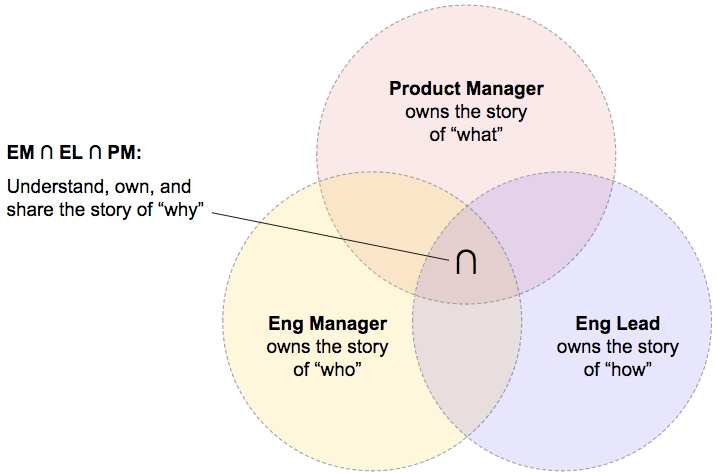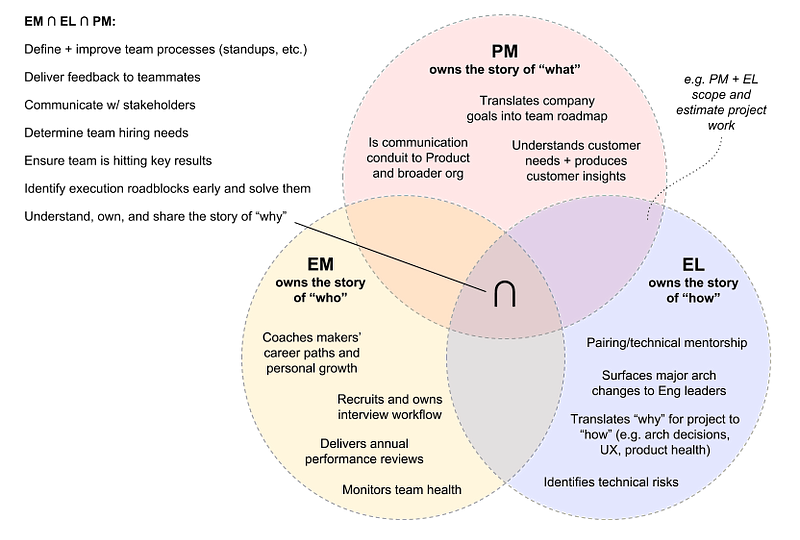Team Leader Venn Diagram – Making Meetup – Medium
A tool for gaining a shared understanding of responsibilities
Upon arrival at Meetup as a “fractional” VP of Engineering, I began to hear something that I hear at lots of organizations: confusion about team leaders’ roles and responsibilities.
Product teams typically have an Engineering Manager, a Product Manager, and sometimes an Engineering Lead; though Meetup’s Engineering Ladder includes descriptions of each of these roles, the overlap of their responsibilities can lead to ambiguity and confusion. This is definitely a common problem, and not unique to Meetup!
Last week, I met with the Engineering Leads and Engineering Managers to share a tool to help them create clarity — which I hope will be useful to lots of organizations! My goals were:
- Provide a tool for gaining shared understanding of team leaders’ roles/responsibilities
- Acknowledge that each team might intentionally have different dividing lines of leaders’ roles/responsibilities
- Add clarity for team leaders’ day-to-day (both for team leaders, and all other teammates)
Voila! A Team Leader Venn Diagram:

Note that the circles overlap, each dividing line is fuzzy, and each role owns a story. So what does this mean in practice?
Because they own the story of “what,” a Product Manager’s responsibilities might include:
- Translating company goals into team roadmap
- Acting as a communication conduit to Product and the broader organization
- Understanding customer needs and producing customer insights
Because they own the story of “how,” an Engineering Lead’s responsibilities might include:
- Pairing/technical mentorship
- Surfacing major architecture changes to Engineering leaders
- Translating the “why” for a project to “how” (e.g. architecture decisions, UX, product health)
- Identifying technical risks
Because they own the story of “who,” an Engineering Manager’s responsibilities might include:
- Coaching makers’ career paths and personal growth
- Recruiting and owning the team’s interview workflow
- Delivering annual performance reviews
- Monitoring team health
The overlaps are really interesting! When we think about the intersection of the story of what and the story of how, an example shared responsibility that a Product Manager and Engineering Lead have could be scoping and estimating project work for the team.
And here are some examples of the intersection of all three:
- Defining and improving team processes (standups, etc.)
- Delivering feedback to teammates
- Communicating with stakeholders
- Determining team hiring needs (as each person provides input from a different point of view)
- Ensuring team is hitting key results
- Identifying execution roadblocks early and solving them
People are not perfect circles! So there’s a high probability that these example bullets don’t map to what any one individual team looks like. A friend of mine likes to say that people are potato shaped — we all have different bumps and divots, and it’s important to understand what your shape is, and how that works alongside the other humans representing these roles.
You can totally use this system to create additional illustrations for other disciplines! EM/EL/PM had the most confusion about role distinction, AND the most overlap, so I used these in the example. But I can imagine a world in which it’s helpful to also draw new diagrams to illustrate responsibilities for designers, analysts, directors, and more!
In some cases, a team doesn’t have an Engineering Lead. On Platform teams at Meetup, there’s currently not a Product Manager role. Documenting which team leader is responsible for which things can illustrate where individuals might be currently overwhelmed with tasks, and provide a clear opportunity for others to step in and help.
How to use the tool
- Schedule a meeting with the other leaders on your team to chat about what could go in each circle, what could go in the overlaps, etc.
- Gain a shared understanding of responsibilities per role on your team, and document it.
- Share the outcome of that meeting with the rest of your team. Answer questions, add clarity, make tweaks as needed.
Here’s an example outcome:

Frantz Joseph, an Engineering Director here at Meetup, just tried out this tool with his team. Here’s what he said:
We had the discussion with our group and it was quite helpful. We are working on a draft document which better defines our exact responsibilities within each role. In the room we made specific decisions about who owns what. Before there were just assumptions and multiple people doing redundant work.
I’m thrilled that this is helping to create clarity for folks at Meetup, and I’m hoping it’s useful for you in your organization, too!

I love this!!!